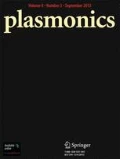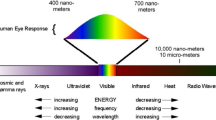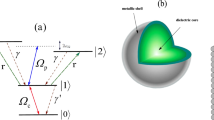Abstract
The hybrid modes in the plasmonic quantum dot (QD) laser are modeled using the Marctili method. The model is then used to study the mode characteristics. The modes are going to cutoff point at zero propagation constant, while it goes to surface plasmon polaritons (SPPs) mode at higher photon energy. This behavior was different from that of waveguide modes shown in the dielectric waveguide. At plasmon resonance, hybrid mode is exactly one mode: surface plasmon polariton mode (perfect electric conductor).









Similar content being viewed by others
References
Chang S, Adrian Ni C, Chuang SL (2008) Theory for bowtie plasmonic nanolasers. Opt Express 16:10580–10595
Adrian Ni C, Chuang SL (2012) Theory of high-speed nanolasers and nanoLEDs. Opt Express 20:16450–16470
Lu C, Chuang SL (2011) A surface-emitting 3D metal-nanocavity laser: proposal and theory. Opt Express 19:13225–13244
Chang S, Lin T, Chuang SL (2010) Theory of plasmonic Fabry-Perot nanolasers. Opt Express 18:15039–15053
Jabir JN, Ameen SMM, Al-Khursan AH (2019) Modeling of dielectric function in plasmonic quantum dot nanolaser. Opt Quant Electron 51:396
Jabir JN, Ameen SMM, Al-Khursan AH (2019) Plasmonic quantum dot nanolaser: effect of waveguide Fermi energy. Plasmonics 14:1881–1891
Adrian Ni C, Chang S, Gargas DJ, Moore MC, Yang P, Chuang SL (2011) Metal-coated zinc oxide Nanocavities. IEEE J Quantum Electronics 47:245–251
Akram H, Al-Khursan AH (2016) Second-order nonlinearity in ladder plus-Y configuration in double quantum dot structure. Appl Opt 55:9866–9874
Al-Khursan AH (2005) Intensity noise characteristics in quantum-dot lasers: four-level rate equations analysis. J Lumin 113:129–136
Vyshnevyy AA, Fedyanin DY (2016) Spontaneous emission and fundamental limitations on the signal-to-noise ratio in deep-subwavelength plasmonic waveguide structures with gain. Phys Rev Appl 6:064024
Lu C-Y, Chuang SL, Bimberg D (2013) Metal-cavity surface-emitting nanolasers. IEEE J Quantum Electronics 49:114–121
Ivanova OV, Hammer M, Stoffer R, van Groesen E (2007) A variational mode expansion mode solver. Opt Quant Electron 39:849–864
Sudbo AS (1994) Improved formulation of the film mode matching method for mode field calculations in dielectric waveguides. Pure Appl Opt 3:381–388
Marcatili EAJ (1969) Dielectric rectangular waveguide and directional coupler for integrated optics. Bell Syst Tech J 48:2071–2102
Westerveld WJ, Leinders SM, Dongen KW, Urbach HP, Yousefi M (2012) Extension of Marcatili’s analytical approach for rectangular silicon optical waveguides. J Lightwave Technol 30:2388–2401
Marcuse D (1991) Theory of dielectric optical waveguides, 2nd Edition. Academic Press, San Diego
Snyder AW, Love JD (1983) Optical waveguide theory. Chapman and Hall, New York
Chuang LS (2009) Physics of photonic devices, 2nd Edition. Wiley, New Jersey
Westerveld WJ, Leinders SM, Pozo J, van Dongen KWA, Yousefi M, Urbach HP (2012) Extension of Marcatili’s analytical approach for 220 nm high waveguides in SOI technology. Conference: 17th Annual Symposium of the IEEE Photonics Society Benelux Chapter, November
Kim J, Chuang SL (2006) Theoretical and experimental study of optical gain, refractive index change, and linewidth enhancement factor of p-doped quantum-dot lasers. IEEE J Quantum Electron 42:942–952
Al-Husseini H, Al-Khursan AH, Al-Dabagh SY (2009) III-N QD lasers. Open Nanosci J 3:1–11
Dwara SN, Al-Khursan AH (2015) Quantum efficiency of InSbBi quantum dot photodetector. Appl Opt 54:9722–9727
Flayyih AH, Al-Khursan AH (2013) Theory of four wave mixing in quantum dot semiconductor optical amplifiers. J Phys D Appl Phys 46:445102
Ahn D, Chuang S-L (1987) Calculation of linear and nonlinear. intersubband optical absorptions in a quantum ode1 with an applied electric field. IEEE J Quantum Electron QE-23:2196–2204
Vahala KJ (1988) Quantum box fabrication tolerance and size limits in semiconductom and their effect on optical gain. IEEE J Quantum Electron 24:523–530
Al-Khursan AH (2006) Gain of excited states in the quantum-dots. Phys E 35:6–8
Huffaker DL, Deppe DG (1998) Electroluminescence efficiency of 1.3 μm wavelength InGaAs/GaAs quantum dots. Appl Phys Lett 73:520–522
Author information
Authors and Affiliations
Corresponding author
Additional information
Publisher’s Note
Springer Nature remains neutral with regard to jurisdictional claims in published maps and institutional affiliations.
Rights and permissions
About this article
Cite this article
Jabir, J.N., Ameen, S.M.M. & Al-Khursan, A.H. Plasmonic Quantum Dot Nanocavity Laser: Hybrid Modes. Plasmonics 15, 1451–1458 (2020). https://doi.org/10.1007/s11468-020-01170-2
Received:
Accepted:
Published:
Issue Date:
DOI: https://doi.org/10.1007/s11468-020-01170-2




